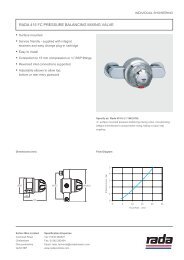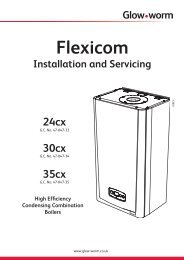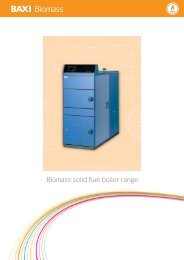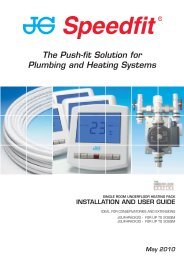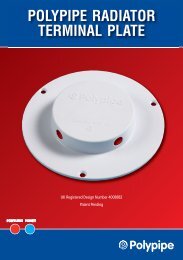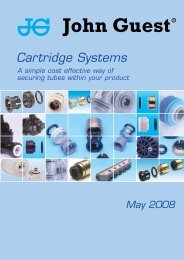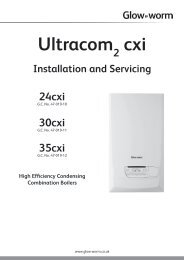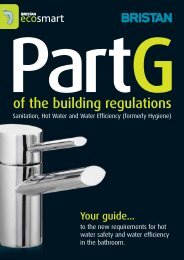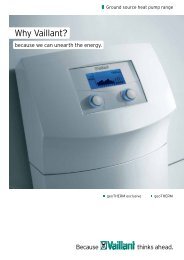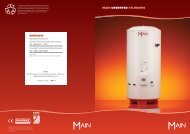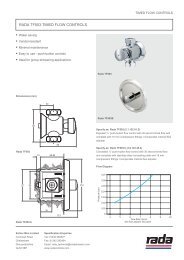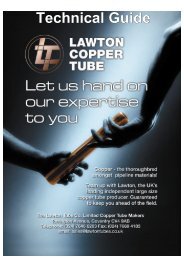Hep20 Technical Handbook
Hep20 Technical Handbook
Hep20 Technical Handbook
You also want an ePaper? Increase the reach of your titles
YUMPU automatically turns print PDFs into web optimized ePapers that Google loves.
Electrical Safety<br />
Hep 2 O ® piping does not conduct<br />
electricity.<br />
However, if Hep 2 O ® forms a break<br />
in the continuity of metal pipework<br />
that is being used for earthing or<br />
bonding, then the break should be<br />
re-bonded to both sections of the<br />
existing pipe when cutting and after<br />
installation.<br />
Main, supplementary and<br />
equipotential bonding<br />
Installers should be aware of the<br />
main and supplementary bonding of<br />
electrical installations where plumbing<br />
is carried out with plastics piping.<br />
1. This guidance is given on the<br />
basis that the following<br />
conditions apply. If they do not<br />
then the installation must be<br />
considered on an individual basis:<br />
•<br />
the gas pipe to the boiler is<br />
metallic.<br />
•<br />
the hot and cold water services<br />
are carried out in Hep 2 O ® .<br />
•<br />
the central heating pipes are<br />
Hep 2 O ® .<br />
• the waste pipes from the bath,<br />
hand basin,WC, bidet and<br />
kitchen sink are plastics.<br />
2. There is no requirement to<br />
supplementary bond the following:<br />
• the bath even if it is metal.<br />
• the kitchen sink.<br />
• central heating radiators.<br />
•<br />
bathroom radiators and towel<br />
rails heated by a wet central<br />
heating system unless there is<br />
less than a 2 metre run of<br />
plastics pipe between them and<br />
the boiler, or between them and<br />
any metallic pipe from the boiler<br />
to which the radiator plastics<br />
pipe is connected.<br />
3. There is no requirement in the<br />
above circumstances to bond a<br />
steel sink but it is not incorrect<br />
to bond a steel sink to the earth<br />
terminal of an adjacent socket.<br />
4. If all the conditions in 1 apply<br />
then the following precautions<br />
must be undertaken.<br />
Items to be mainbonded:<br />
• the consumer’s gas pipe at the<br />
service entry.<br />
•<br />
any other services that are<br />
metallic, e.g. heating oil pipes.<br />
•<br />
structural steel should be bonded<br />
to the main earth terminal.<br />
Items to be supplementary bonded (in<br />
the bathroom):<br />
•<br />
the earth terminal of the lighting<br />
point (rose, luminaire support<br />
coupling, luminaire).<br />
•<br />
the earth terminal of the electric<br />
radiant heater (if any).<br />
•<br />
the earth terminal of the electric<br />
shower water heater (if any).<br />
•<br />
the earth terminal of any other<br />
appliance.<br />
There is no need to connect the<br />
supplementary bonding conductor<br />
to the main earth bar.<br />
Supplementary bonding in a<br />
bathroom when Hep 2 O ® and<br />
plastics soil and waste pipes<br />
have been installed<br />
(Refer to Figure 3)<br />
There is no requirement to<br />
supplementary bond:<br />
• Hep 2 O® pipes.<br />
• plastic soil and waste pipes.<br />
•<br />
visible copper pipes less than<br />
0.5m long.<br />
• metal taps.<br />
•<br />
metal baths not connected to<br />
extraneous conductive parts (i.e.<br />
structural steelwork).<br />
However, metal (Class 1) items of<br />
equipment in a bathroom or shower<br />
room (e.g. electric heaters, showers<br />
and luminaires) will require<br />
supplementary bonding if<br />
simultaneously accessible.<br />
45<br />
Supplementary bonds must be<br />
connected to the protective<br />
conductors of each circuit at the<br />
accessory point.<br />
Supplementary bonding in a<br />
bathroom when metallic<br />
service pipes, soil pipes and<br />
waste pipes have been installed<br />
(Refer to Figure 4)<br />
Supplementary bonding will be a<br />
requirement for:<br />
• all simultaneously accessible<br />
metal (Class 1) equipment (e.g.<br />
electric heaters and showers).<br />
• central heating pipes.<br />
• hot and cold water pipes.<br />
• waste and soil pipes.<br />
Pipe connections should be made<br />
with BS 951 clamps, complete with<br />
a ‘safety electrical connection’ label.<br />
However, metal baths not connected<br />
to a metal building structure do not<br />
require supplementary bonding if all<br />
metal pipes connected to them have<br />
been bonded.<br />
Hep 2 O ® pipe<br />
Hep 2 O ® pipes<br />
Figure 3<br />
Metal pipe<br />
Figure 4<br />
Wall heater<br />
Wall heater<br />
Metal pipes<br />
Accessible metal<br />
luminaire<br />
Plastic soil<br />
pipe<br />
Shower<br />
Plastic waste pipes<br />
Supplementary bond<br />
Accessible metal<br />
luminaire<br />
Metal soil<br />
pipe<br />
Shower<br />
Metal waste pipes<br />
Supplementary bond



